-
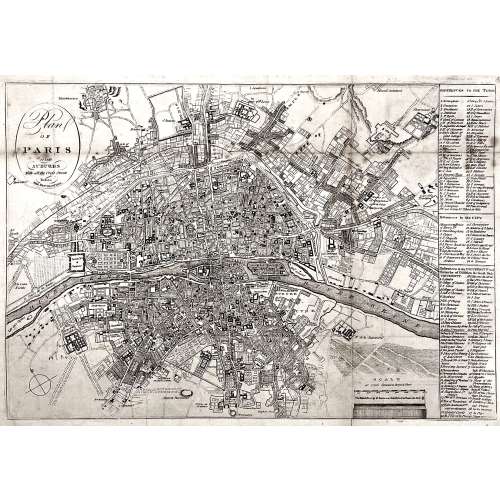 Oval cartouche in the upper-left corner, with tall “s”: Plan | OF | PARIS | and | SUBURBS | With all the Cross Streets | Before | THE REVOLUTION. || No indication of the makers. Dimensions: Sheet: 32.5 x 44.3 cm; Image: 28.5 x 41.3 cm.
Oval cartouche in the upper-left corner, with tall “s”: Plan | OF | PARIS | and | SUBURBS | With all the Cross Streets | Before | THE REVOLUTION. || No indication of the makers. Dimensions: Sheet: 32.5 x 44.3 cm; Image: 28.5 x 41.3 cm. -
 Utagawa Kunisada [歌川 国貞]; a.k.a. Utagawa Toyokuni III [三代歌川豊国] (Japanese, 1786 – 1865). Signed: Toyokuni ga [豊国 画] in a yellow toshidama cartouche. Publisher: Unknown, seal [久] Kyū (Japanese, fl. c. 1851 – 1861); (Marks 07-023 | U176a, possibly Sagamia Kyūzō). Date seal and double nanushi censor seals: Fuku & Muramatsu, Kaei 6, 2nd month (2/1853). Inscription in a red cartouche: Purple of Edo // Purple of the Bay Capital [江都むらさき] (Edo Murasaki), alluding to Murasaki Shikibu [紫 式部] (Japanese, c. 973/8 – c. 1014/31), the author of Genji Monogatari [源氏物語] (The Tale of Genji), a Heian period novel which was the source of a parody Nise Murasaki Inaka Genji [偐紫田舎源氏] (Fake Murasaki’s Rustic Genji) by Ryutei Tanehiko [柳亭種彦] (Japanese, 1783 – 1842). According to Horst Graebner: The actor is most probably Iwai Kumesaburō III. Iwai Hanshirō VIII [岩井半四郎] (Japanese, 1829 – 1882); other names: Iwai Shijaku II, Iwai Kumesaburō III [岩井粂三郎], Iwai Hisajirō II. One of the series of Kunisada's fan prints in this collection:
Utagawa Kunisada [歌川 国貞]; a.k.a. Utagawa Toyokuni III [三代歌川豊国] (Japanese, 1786 – 1865). Signed: Toyokuni ga [豊国 画] in a yellow toshidama cartouche. Publisher: Unknown, seal [久] Kyū (Japanese, fl. c. 1851 – 1861); (Marks 07-023 | U176a, possibly Sagamia Kyūzō). Date seal and double nanushi censor seals: Fuku & Muramatsu, Kaei 6, 2nd month (2/1853). Inscription in a red cartouche: Purple of Edo // Purple of the Bay Capital [江都むらさき] (Edo Murasaki), alluding to Murasaki Shikibu [紫 式部] (Japanese, c. 973/8 – c. 1014/31), the author of Genji Monogatari [源氏物語] (The Tale of Genji), a Heian period novel which was the source of a parody Nise Murasaki Inaka Genji [偐紫田舎源氏] (Fake Murasaki’s Rustic Genji) by Ryutei Tanehiko [柳亭種彦] (Japanese, 1783 – 1842). According to Horst Graebner: The actor is most probably Iwai Kumesaburō III. Iwai Hanshirō VIII [岩井半四郎] (Japanese, 1829 – 1882); other names: Iwai Shijaku II, Iwai Kumesaburō III [岩井粂三郎], Iwai Hisajirō II. One of the series of Kunisada's fan prints in this collection: -
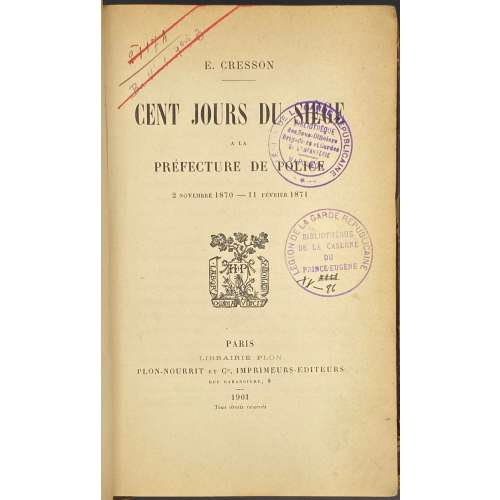 Title-page: E. CRESSON |—| CENT JOURS DE SIÈGE | A LA | PRÉFECTURE DE POLICE | 2 NOVEMBRE 1870 — 11 FÉVRIER 1871 | {publisher’s device} | PARIS | LIBRAIRIE PLON | PLON-NOURRIT ET Cie, IMPRIMEURS-ÉDITEURS | RUE GARANCIÈRE, 8 | 1901 | Tous droits réservés || Description: 8vo, 22 x 14.5 cm, quarter brown calf over marbled boards, flat spine with gilt fillets, gilt lettering, marbled endpapers; inscriptions to t.p.: 2117 A | Ba V –1 1bis 3; ink stamps to t.p.: (1) « LÉGION DE LA GARDE REPUBLICAINE | BIBLIOTÈQUE | des Sous-Officiers | Brigadiers et Gardes | DE L’INFANTERIA | NAPOLEON » ; (2) « LÉGION DE LA GARDE REPUBLICAINE | BIBLIOTÈQUE | DE LA CASERNE | DU | PRINCE-EUGÈNE | (hand) XIII | XX—86 » Collation: 8vo; π6 1-248 252, total 200 leaves. Pagination: [2] [i-v] vi-x, [1] 2-385 [3], total 400 pages. BNF: ark:/12148/bpt6k4936n Author: Ernest Cresson (French, 1824 – 1902)
Title-page: E. CRESSON |—| CENT JOURS DE SIÈGE | A LA | PRÉFECTURE DE POLICE | 2 NOVEMBRE 1870 — 11 FÉVRIER 1871 | {publisher’s device} | PARIS | LIBRAIRIE PLON | PLON-NOURRIT ET Cie, IMPRIMEURS-ÉDITEURS | RUE GARANCIÈRE, 8 | 1901 | Tous droits réservés || Description: 8vo, 22 x 14.5 cm, quarter brown calf over marbled boards, flat spine with gilt fillets, gilt lettering, marbled endpapers; inscriptions to t.p.: 2117 A | Ba V –1 1bis 3; ink stamps to t.p.: (1) « LÉGION DE LA GARDE REPUBLICAINE | BIBLIOTÈQUE | des Sous-Officiers | Brigadiers et Gardes | DE L’INFANTERIA | NAPOLEON » ; (2) « LÉGION DE LA GARDE REPUBLICAINE | BIBLIOTÈQUE | DE LA CASERNE | DU | PRINCE-EUGÈNE | (hand) XIII | XX—86 » Collation: 8vo; π6 1-248 252, total 200 leaves. Pagination: [2] [i-v] vi-x, [1] 2-385 [3], total 400 pages. BNF: ark:/12148/bpt6k4936n Author: Ernest Cresson (French, 1824 – 1902) -
 Title: Modori Kago [戻駕] (Returning palanquin). The dance-drama Modori Kago Iro ni Aikata [戻駕色相肩] premiered in the 11th lunar month of 1788 at the Nakamuraza [中村座], within Sakurada Jisuke I's kaomise [顔見世] (faceshowing) program Tôzumô Hana no Edogata [唐相撲花江戸方]", which celebrated the homecoming to Edo, after two years' absence, of Nakamura Nakazō I, and was intended to show off his particular talents in the role of Jirosaku (in reality Ishikawa Goemon [石川 五右衛門]) [kabuki21]. The symbol on a green book cover is the informal crest of tokiwazu-bushi [常磐津節] shaped like a water chestnut (Eleocharis dulcis) lozenge. Artist signature 国盛画 (Kunimori ga) with red toshidama. According to Samuel L. Leiter’s Kabuki Encyclopedia (1979), p. 243: The palanquin bearers Nanpa no Jirosaku and Azuma no Yōshirō, who are bearing a palanquin with a courtesan's young handmaiden in it, stop to rest at Kyoto's Murasakino, and each dances his regional dance. Then they call the girl, who does a dance showing the visitors to the famous pleasure quarters, Yoshiwara and Shimabara. The two men recognize each other as Ishikawa Goemon and Masashiba Hisayoshi, sworn enemies, and engage in a fight. This number is the only remaining section of an annual "faceshowing” (kaomize) work with a plot based on the medieval chronicle called the Toikōki. The full-length piece was called Kara Sumō Hanaeda no Kata. It is one of the most famous tokiwazu pieces and preserves the old-style Kabuki flavour. Nakamura Nakazō I played Jirosaku and Matsumoto Kōshirō IV was Yoshiro in the first production. The handmaiden was Matsumoto Komesaburō (probably Matsumoto Komasaburō I, an unknown actor [SV]). According to Egenolf Gallery: This work was first performed in 1788 at the Edo Nakamura-za as the season’s first performance and featured Nakamura Nakazō, who returned to Edo after three years in Osaka. It was a dance with tokiwazu chanting and was designed for him to play the lead role. In the piece, two palanquin carriers, one from Osaka, another from Edo, and a passenger – a kamuro, (a young geisha-in-training) exchange stories about the pleasure quarters of Shimabara and Yoshiwara. The text of the chanting book is open next to her, carrying the title “Collection of Practicing” [稽古尽くし], on which the green bundle cover carries the crest of Tokiwazu School, matsu-kawa-bishi, diamond variety of pine bark and the artist’s signature. Tokiwazu is a type of jōruri, narrative music, and accompanies dancing on the kabuki stage. Ref.: Christie's 27 Mar 2006. Publisher: Maruya Jinpachi, seal Marujin (Marks: 12-029 | 294e) Single nanushi censor seal: Mura (Murata Sahei, 1842-46). Provenance: Circular seal of the collector Huguette Bérès to verso. Contributors: Utagawa Kunimori [歌川国盛] (Japanese, fl. c. 1818 – 1943) – artist. Maruya Jinpachi [丸屋甚八] (Japanese, fl. 1770 – 1842) – publisher. Other mentioned: Nakamura Nakazō I [中村仲蔵] (Japanese, 1736 – 1790); other names: Nakayama Kojūrō VI, Nakamura Ichijūrō, Nakayama Manzō – actor. Matsumoto Kōshirō IV [松本幸四郎] (Japanese, 1737 – 1802); other names: Omegawa Kyōjūrō; Ichikawa Komazō II, Ichikawa Somegorô I, Ichikawa Takejūrō ; Segawa Kinji; Segawa Kingo – actor. Sakurada Jisuke I [桜田治助] (Japanese, 1734 – 1806) – dramatist.
Title: Modori Kago [戻駕] (Returning palanquin). The dance-drama Modori Kago Iro ni Aikata [戻駕色相肩] premiered in the 11th lunar month of 1788 at the Nakamuraza [中村座], within Sakurada Jisuke I's kaomise [顔見世] (faceshowing) program Tôzumô Hana no Edogata [唐相撲花江戸方]", which celebrated the homecoming to Edo, after two years' absence, of Nakamura Nakazō I, and was intended to show off his particular talents in the role of Jirosaku (in reality Ishikawa Goemon [石川 五右衛門]) [kabuki21]. The symbol on a green book cover is the informal crest of tokiwazu-bushi [常磐津節] shaped like a water chestnut (Eleocharis dulcis) lozenge. Artist signature 国盛画 (Kunimori ga) with red toshidama. According to Samuel L. Leiter’s Kabuki Encyclopedia (1979), p. 243: The palanquin bearers Nanpa no Jirosaku and Azuma no Yōshirō, who are bearing a palanquin with a courtesan's young handmaiden in it, stop to rest at Kyoto's Murasakino, and each dances his regional dance. Then they call the girl, who does a dance showing the visitors to the famous pleasure quarters, Yoshiwara and Shimabara. The two men recognize each other as Ishikawa Goemon and Masashiba Hisayoshi, sworn enemies, and engage in a fight. This number is the only remaining section of an annual "faceshowing” (kaomize) work with a plot based on the medieval chronicle called the Toikōki. The full-length piece was called Kara Sumō Hanaeda no Kata. It is one of the most famous tokiwazu pieces and preserves the old-style Kabuki flavour. Nakamura Nakazō I played Jirosaku and Matsumoto Kōshirō IV was Yoshiro in the first production. The handmaiden was Matsumoto Komesaburō (probably Matsumoto Komasaburō I, an unknown actor [SV]). According to Egenolf Gallery: This work was first performed in 1788 at the Edo Nakamura-za as the season’s first performance and featured Nakamura Nakazō, who returned to Edo after three years in Osaka. It was a dance with tokiwazu chanting and was designed for him to play the lead role. In the piece, two palanquin carriers, one from Osaka, another from Edo, and a passenger – a kamuro, (a young geisha-in-training) exchange stories about the pleasure quarters of Shimabara and Yoshiwara. The text of the chanting book is open next to her, carrying the title “Collection of Practicing” [稽古尽くし], on which the green bundle cover carries the crest of Tokiwazu School, matsu-kawa-bishi, diamond variety of pine bark and the artist’s signature. Tokiwazu is a type of jōruri, narrative music, and accompanies dancing on the kabuki stage. Ref.: Christie's 27 Mar 2006. Publisher: Maruya Jinpachi, seal Marujin (Marks: 12-029 | 294e) Single nanushi censor seal: Mura (Murata Sahei, 1842-46). Provenance: Circular seal of the collector Huguette Bérès to verso. Contributors: Utagawa Kunimori [歌川国盛] (Japanese, fl. c. 1818 – 1943) – artist. Maruya Jinpachi [丸屋甚八] (Japanese, fl. 1770 – 1842) – publisher. Other mentioned: Nakamura Nakazō I [中村仲蔵] (Japanese, 1736 – 1790); other names: Nakayama Kojūrō VI, Nakamura Ichijūrō, Nakayama Manzō – actor. Matsumoto Kōshirō IV [松本幸四郎] (Japanese, 1737 – 1802); other names: Omegawa Kyōjūrō; Ichikawa Komazō II, Ichikawa Somegorô I, Ichikawa Takejūrō ; Segawa Kinji; Segawa Kingo – actor. Sakurada Jisuke I [桜田治助] (Japanese, 1734 – 1806) – dramatist. -
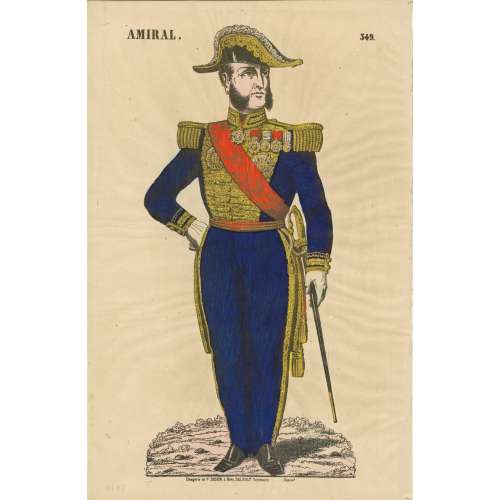 Hand-coloured woodcut on wove paper, 440 x 285 mm; black ink stamp “5049” to reverse. Top left: "AMIRAL"; right: "349". Below: "Imagerie de DIDION, à Metz, DELHALT Successeur." — "Déposé." Paulin Didion (French, 1831 – 1879) – publisher/printer.
Hand-coloured woodcut on wove paper, 440 x 285 mm; black ink stamp “5049” to reverse. Top left: "AMIRAL"; right: "349". Below: "Imagerie de DIDION, à Metz, DELHALT Successeur." — "Déposé." Paulin Didion (French, 1831 – 1879) – publisher/printer. -
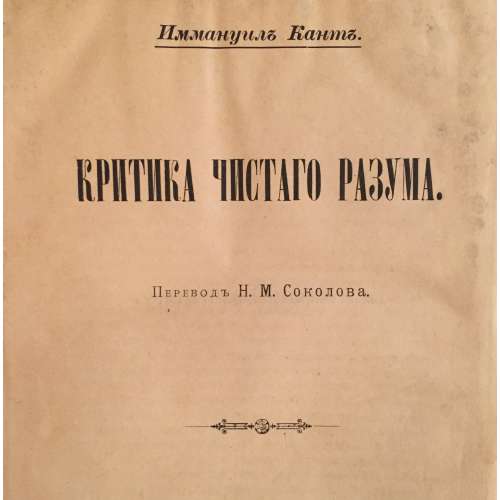 Иммануил Кант. Критика чистого разума. Пер. Н. М. Соколова. С.-Петербург. Издание книжного магазина М. В. Попова, 1897. - 674 с.
Иммануил Кант. Критика чистого разума. Пер. Н. М. Соколова. С.-Петербург. Издание книжного магазина М. В. Попова, 1897. - 674 с. -
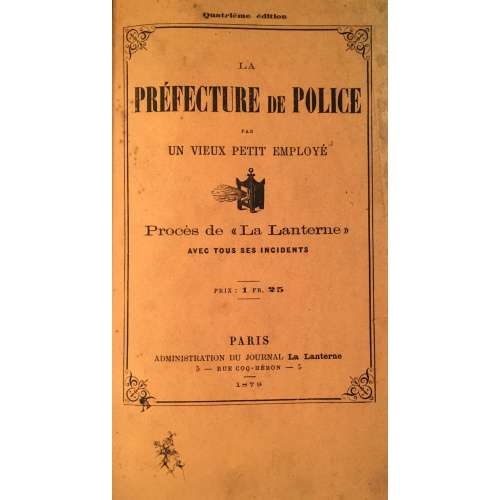
La Préfecture de Police, par un vieux petit employé - Procès de La Lanterne avec tous ses incidents. Administration du journal La Lanterne, Paris, 1879.
Quatrième édition.
Anonymous publication. Authorship attributed to: Yves Guyot, Francisque Sarcey. Source: Harvard College Library, Soc. 3375.6, 14-OCT-1914, Wolcott Fund.
-

Kitagawa Tsukimaro (Kikumaro): 喜多川 月麿, fl. c. 1794–1836.
Mother is playing with her child: they left playing with shadow lantern for freeing a turtle (Hojo-e, or "Rite for the Release of Living Beings").Signed: Tsukimaro hitsu (月麿筆); Publisher's mark; censor's seal: Kiwame + Yamaguchiya Tôbei gyōji seal (1811-14).
-
 Title: Lyon Collection: Genji, Chapter 21, the maiden (otome - 乙女): the nine-tailed fox woman (kayō-fujin [花陽夫人]) terrorizing Prince Hanzoku (足王) and his servant from the series Japanese and Chinese parallels to Genji (wakan nazorae genji - 和漢准源氏). British Museum: Otome 乙女 (Maiden) / Waken nazorae Genji 和漢准源氏 (Japanese and Chinese Comparisons for the Chapters of the Genji). Schaap: Prince Hanzoku terrorized by a nine-tailed fox; Series: Wakan nazorae Genji (Japanese and Chinese parallels to Genji) Artist: Utagawa Kuniyoshi [歌川 國芳] (1798 – 1861). Publisher: Iseyoshi [伊勢芳] (Marks 25-013 | U095); seal [イせ芳]. Block carver: Hori Shōji [彫庄治] (Lyon Collection; BM); Hori Takichi [彫多吉] (Schaap). Date-aratame seal: Ansei 2, 7th month (1855). Ref: Jack Hillier. Japanese prints and drawings from the Vever Collection (3 volumes). — New York: Sotheby Parke Bernet & Rizzoli International, 1976; vol.3, p. 868, pl. 847. Robinson (1982): p. 161, S88, № 21. Schaap (1998): p. 115, № 107. SOLD
Title: Lyon Collection: Genji, Chapter 21, the maiden (otome - 乙女): the nine-tailed fox woman (kayō-fujin [花陽夫人]) terrorizing Prince Hanzoku (足王) and his servant from the series Japanese and Chinese parallels to Genji (wakan nazorae genji - 和漢准源氏). British Museum: Otome 乙女 (Maiden) / Waken nazorae Genji 和漢准源氏 (Japanese and Chinese Comparisons for the Chapters of the Genji). Schaap: Prince Hanzoku terrorized by a nine-tailed fox; Series: Wakan nazorae Genji (Japanese and Chinese parallels to Genji) Artist: Utagawa Kuniyoshi [歌川 國芳] (1798 – 1861). Publisher: Iseyoshi [伊勢芳] (Marks 25-013 | U095); seal [イせ芳]. Block carver: Hori Shōji [彫庄治] (Lyon Collection; BM); Hori Takichi [彫多吉] (Schaap). Date-aratame seal: Ansei 2, 7th month (1855). Ref: Jack Hillier. Japanese prints and drawings from the Vever Collection (3 volumes). — New York: Sotheby Parke Bernet & Rizzoli International, 1976; vol.3, p. 868, pl. 847. Robinson (1982): p. 161, S88, № 21. Schaap (1998): p. 115, № 107. SOLD -
![Charles Virmaitre. Paris-police. — Paris: E. Dentu, 1886. — pp.: [2 wrapper], [2 half-title], 2 title] 1-359 [1 blank], back wrapper.](https://varshavskycollection.com/wp-content/uploads/2021/02/LIB-1130.2016-d-scaled-500x500.jpeg) Cover: (black and red in red frame) PARIS POLICE | par | Ch. Virmaitre | PARIS | E. DENTU, ÉDITEUR | LIBRAIRE DE LA SOCIÉTÉ DES GENTES DE LETTRES | Palais-Royal, 15-17-19, Galerie d’Orléans | 1886 || Title page: CH. VIRMAITRE | PARIS–POLICE | {publisher’s device} | PARIS | E. DENTU, ÉDITEUR | LIBRAIRE DE LA SOCIÉTÉ DES GENTES DE LETTRES | PALAIS-ROYAL, 15-17-19, GALERIE D’ORLEANS | 1886 | Tous droits réservés. || Pagination : 3 blank leaves, original pictorial wrapper, [4], [1] 2-359 [360 blank], original back wrapper with publisher's advertisement, 3 blank leaves. Collation: 12mo; π2, 1-1912 206. Binding: owner's hardcover, quarter burgundy percaline, marbled boards, brown title label with gilt lettering, gilt double tail ruler, year, and fleuron to spine; original paper wrappers preserved.
Cover: (black and red in red frame) PARIS POLICE | par | Ch. Virmaitre | PARIS | E. DENTU, ÉDITEUR | LIBRAIRE DE LA SOCIÉTÉ DES GENTES DE LETTRES | Palais-Royal, 15-17-19, Galerie d’Orléans | 1886 || Title page: CH. VIRMAITRE | PARIS–POLICE | {publisher’s device} | PARIS | E. DENTU, ÉDITEUR | LIBRAIRE DE LA SOCIÉTÉ DES GENTES DE LETTRES | PALAIS-ROYAL, 15-17-19, GALERIE D’ORLEANS | 1886 | Tous droits réservés. || Pagination : 3 blank leaves, original pictorial wrapper, [4], [1] 2-359 [360 blank], original back wrapper with publisher's advertisement, 3 blank leaves. Collation: 12mo; π2, 1-1912 206. Binding: owner's hardcover, quarter burgundy percaline, marbled boards, brown title label with gilt lettering, gilt double tail ruler, year, and fleuron to spine; original paper wrappers preserved. -
 Artist: Utagawa Kunisada [歌川 国貞] a.k.a. Utagawa Toyokuni III [三代歌川豊国] (Japanese, 1786 – 1865). Signed: Kunisada ga [国貞画] in a yellow double-gourd cartouche. Publisher: Ibaya Senzaburo [伊場屋仙三郎] (Japanese, fl. c. 1845 – 1847). Date aratame seal: Bunsei 13 – Tenpō 1 (1830). Actor: Nakamura Utaemon IV [中村歌右衛門] (Japanese, 1796 – 1852); other names: Nakamura Shikan II [二代目中村芝翫], Nakamura Tsurusuke I, Nakamura Tōtarō. Play: Yoshitsune’s Letter at Koshigoe [義経腰越状] (Yoshitsune Koshigoe-jo). Uncut fan print (uchiwa-e, 団 扇 絵), 229 x 267 mm, depicting kabuki actor Nakamura Shikan [中村芝翫] as Gotobei [五斗兵衛]. Nakamura Utaemon IV held the name of Nakamura Shikan II from the 11th lunar month of 1825 to the 1st lunar month of 1836. He was born as Hirano Kichitarō in Edo in 1796. Another fan print with the same subject in this collection [SVJP-0344.2021]:
Artist: Utagawa Kunisada [歌川 国貞] a.k.a. Utagawa Toyokuni III [三代歌川豊国] (Japanese, 1786 – 1865). Signed: Kunisada ga [国貞画] in a yellow double-gourd cartouche. Publisher: Ibaya Senzaburo [伊場屋仙三郎] (Japanese, fl. c. 1845 – 1847). Date aratame seal: Bunsei 13 – Tenpō 1 (1830). Actor: Nakamura Utaemon IV [中村歌右衛門] (Japanese, 1796 – 1852); other names: Nakamura Shikan II [二代目中村芝翫], Nakamura Tsurusuke I, Nakamura Tōtarō. Play: Yoshitsune’s Letter at Koshigoe [義経腰越状] (Yoshitsune Koshigoe-jo). Uncut fan print (uchiwa-e, 団 扇 絵), 229 x 267 mm, depicting kabuki actor Nakamura Shikan [中村芝翫] as Gotobei [五斗兵衛]. Nakamura Utaemon IV held the name of Nakamura Shikan II from the 11th lunar month of 1825 to the 1st lunar month of 1836. He was born as Hirano Kichitarō in Edo in 1796. Another fan print with the same subject in this collection [SVJP-0344.2021]: "...The play Yoshitsune Koshigoe-jo was originally written for the puppet theatre (Bunraku) and staged for the first time in the 7th lunar month of 1754 in Ôsaka at the Toyotakeza. It was a revision of two early plays, Namiki Sōsuke's Nanbantetsu Gotō no Menuki (1735) and Yoshitsune Shin Fukumijō (1744). The title, which suggested that the play focused on Minamoto no Yoshitsune, was in fact dealing with the siege of the Ōsaka Castle, led by Tokugawa Ieyasu to destroy the Toyotomi clan in 1614 and 1615. This play was quickly forbidden because of the 4th act in which Gotobei's wife fired a gun at Yoritomo (this was of course interpreted as an attack on the Shogunate). Yoshitsune Koshigoe-jo was revised in 1770 by Toyotake Ōritsu, who completely rewrote the 4th act for a puppet production at the Kitahorieza in Ōsaka". Yoshitsune Koshigoe-jo was staged for the first time in Edo, at the Ichimuraza on the 9th lunar month of 1790, and is still performed.
Gotobei [五斗兵衛] (Gotohei or Gotobē), one of Yoshitsune’s loyal retainers, is forced to choose between his son’s life or his loyalty to Yoshitsune. Nishikidō brothers, who do not want Gotobei to become Yoshitsune's chief strategist, forced him to drink sake and get asleep. To prove Gotobei's military abilities, Izumi no Saburō fires a gun next to Gotobei's ear, and "he jumps up immediately, in full possession of his senses, ready to repulse any enemy". See: [LIB-1193.2013] Samuel L. Leiter. Kabuki Encyclopedia: An English-language adaptation of Kabuki Jiten. — Westport, CT; London: Greenwood Press, 1979; pp. 266-7).
Ref: [LIB-2993.2022] Fig. 24 in Israel Goldman. Japanese prints and paintings / 40th anniversary; Catalogue 27, 2021.
Two more Kunisada's fan prints (in Paul Griffith's collection), depicting the same actor Nakamura Shikan II as Toneri Matsuōmaru [舎人松王丸] were published in 1832 by Iseya Ichiemon. The play was Sugawara's Secrets of Calligraphy [菅原伝授手習鑑] (Sugawara Denju Tenarai Kagami). See: [LIB-1212.2017] Robert Schaap. Kunisada: Imaging, drama and beauty / Introduction by Sebastian Izzard, contributions by Paul Griffith and Henk. J. Herwig. — Leiden: Hotei Publishing, ©2016.
"...The play Yoshitsune Koshigoe-jo was originally written for the puppet theatre (Bunraku) and staged for the first time in the 7th lunar month of 1754 in Ôsaka at the Toyotakeza. It was a revision of two early plays, Namiki Sōsuke's Nanbantetsu Gotō no Menuki (1735) and Yoshitsune Shin Fukumijō (1744). The title, which suggested that the play focused on Minamoto no Yoshitsune, was in fact dealing with the siege of the Ōsaka Castle, led by Tokugawa Ieyasu to destroy the Toyotomi clan in 1614 and 1615. This play was quickly forbidden because of the 4th act in which Gotobei's wife fired a gun at Yoritomo (this was of course interpreted as an attack on the Shogunate). Yoshitsune Koshigoe-jo was revised in 1770 by Toyotake Ōritsu, who completely rewrote the 4th act for a puppet production at the Kitahorieza in Ōsaka". Yoshitsune Koshigoe-jo was staged for the first time in Edo, at the Ichimuraza on the 9th lunar month of 1790, and is still performed.
Gotobei [五斗兵衛] (Gotohei or Gotobē), one of Yoshitsune’s loyal retainers, is forced to choose between his son’s life or his loyalty to Yoshitsune. Nishikidō brothers, who do not want Gotobei to become Yoshitsune's chief strategist, forced him to drink sake and get asleep. To prove Gotobei's military abilities, Izumi no Saburō fires a gun next to Gotobei's ear, and "he jumps up immediately, in full possession of his senses, ready to repulse any enemy". See: [LIB-1193.2013] Samuel L. Leiter. Kabuki Encyclopedia: An English-language adaptation of Kabuki Jiten. — Westport, CT; London: Greenwood Press, 1979; pp. 266-7).
Ref: [LIB-2993.2022] Fig. 24 in Israel Goldman. Japanese prints and paintings / 40th anniversary; Catalogue 27, 2021.
Two more Kunisada's fan prints (in Paul Griffith's collection), depicting the same actor Nakamura Shikan II as Toneri Matsuōmaru [舎人松王丸] were published in 1832 by Iseya Ichiemon. The play was Sugawara's Secrets of Calligraphy [菅原伝授手習鑑] (Sugawara Denju Tenarai Kagami). See: [LIB-1212.2017] Robert Schaap. Kunisada: Imaging, drama and beauty / Introduction by Sebastian Izzard, contributions by Paul Griffith and Henk. J. Herwig. — Leiden: Hotei Publishing, ©2016.


-
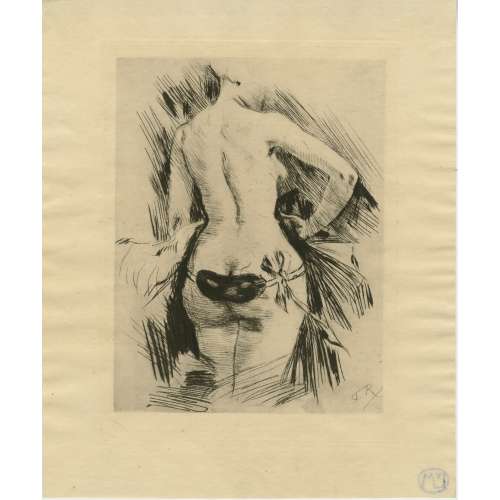
Etching and drypoint on wove paper, depicting a woman with a face mask on her buttocks. Monogrammed in the plate 'FR'. Owner's stamp 'LvM' on verso.
Dimensions: Papaer: 22.2 x 18.5 cm; Plate: 17.5 x 13.3 cm; Image: 15.5 x 12 cm.
Catalogue raisonné: Arthur Hubschmid (1977): 448; Graphics irreverent and erotic (1968): 106; Rouir 648.
-
 One of five fan prints from the series The Pride of Edo Compared to the Five Elements [Edo jiman mitate gogyo]. Artist: Utagawa Hiroshige [歌川 広重] a.k.a. Andō Hiroshige [安藤 広重] (Japanese, 1797 – 1858). Publisher: Ibaya Kyubei [伊場屋 久兵衛] (Japanese, fl. 1804 – 1851). Signed: Hiroshige ga Censor’s seal: Muramatsu Publisher's seal: Kinseido (Ibaya Kyubei) The text in the fan-shaped cartouche reads: "Water: The Square Aqueduct that Crosses by Suido Bridge Suggests the comparison of Ochanomizu to Water [Mizu: Ochanomizu josui no himasu Suidobashi areba gogyo no uchi mizu ni nazorau]". Ref: Rupert Faulkner. Hiroshige Fan Prints. Victoria and Albert Museum. Far Eastern Series. Hardcover - Harry N. Abrams, Inc. - 2001 [LIB-1344.2017] № 22, p. 51. Comment from Sebastian Izzard: This series of five prints features full-length figures of women set in landscapes around Edo compared to the five natural elements: fire, water, earth, wood, and metal. A preparatory drawing for the “Wood” image, featuring a woman crossing a bridge in the snow at the timber yards of Fukagawa, is owned by the Kanagawa Prefectural Museum of History in Yokohama. A preparatory drawing also exists for the “Earth” image, which portrays a woman seated on a bench at Nakabashi, for which no print is extant. Two examples exist of the “Fire” subject, which pictures a woman holding a lantern at night on an embankment, while in the river behind her fishermen employ fire to trap their catch. The “Water” image depicts a woman on a pleasure boat on the Ocha-no-mizu waterway. One example of the “Metal” subject is known, which was included in Izzard's Important Japanese Prints 1830–1860 March 14–20, 2020 exhibition [LIB-2398.2020], as №. 51.
One of five fan prints from the series The Pride of Edo Compared to the Five Elements [Edo jiman mitate gogyo]. Artist: Utagawa Hiroshige [歌川 広重] a.k.a. Andō Hiroshige [安藤 広重] (Japanese, 1797 – 1858). Publisher: Ibaya Kyubei [伊場屋 久兵衛] (Japanese, fl. 1804 – 1851). Signed: Hiroshige ga Censor’s seal: Muramatsu Publisher's seal: Kinseido (Ibaya Kyubei) The text in the fan-shaped cartouche reads: "Water: The Square Aqueduct that Crosses by Suido Bridge Suggests the comparison of Ochanomizu to Water [Mizu: Ochanomizu josui no himasu Suidobashi areba gogyo no uchi mizu ni nazorau]". Ref: Rupert Faulkner. Hiroshige Fan Prints. Victoria and Albert Museum. Far Eastern Series. Hardcover - Harry N. Abrams, Inc. - 2001 [LIB-1344.2017] № 22, p. 51. Comment from Sebastian Izzard: This series of five prints features full-length figures of women set in landscapes around Edo compared to the five natural elements: fire, water, earth, wood, and metal. A preparatory drawing for the “Wood” image, featuring a woman crossing a bridge in the snow at the timber yards of Fukagawa, is owned by the Kanagawa Prefectural Museum of History in Yokohama. A preparatory drawing also exists for the “Earth” image, which portrays a woman seated on a bench at Nakabashi, for which no print is extant. Two examples exist of the “Fire” subject, which pictures a woman holding a lantern at night on an embankment, while in the river behind her fishermen employ fire to trap their catch. The “Water” image depicts a woman on a pleasure boat on the Ocha-no-mizu waterway. One example of the “Metal” subject is known, which was included in Izzard's Important Japanese Prints 1830–1860 March 14–20, 2020 exhibition [LIB-2398.2020], as №. 51.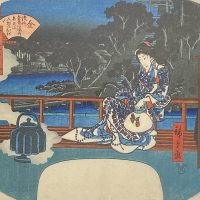
Metal. Izzard, 2020.
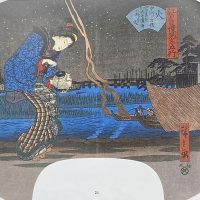
Fire. Faulkner, 2001.
-
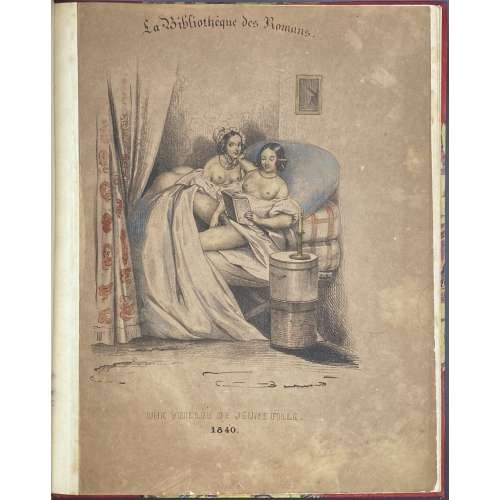 Description: Pictorial album 29.7 x 24 cm, bound in ¾ red morocco over marbled boards with gilt lettering “LA BIBLIOTHÈQUE DES ROMANS” and raised bands to spine; marbled endpapers, two flyleaves, tan original wrapper lettered “La Bibliothèque des Romans. (gothic, arch) | {colour vignette} | UNE VEILLÉE DE JEUNE FILLE. | 1840. || Six hand-coloured lithographs, each in a double-rule border with the series title above it and image title below. Sequential numbers are hand-inscribed within the border in the upper-right corner. Frame 23.5 x 18.3 cm, image 21.5 x 16.5 cm. Three flyleaves at the end. A bookplate to front pastedown: “GERARD NORDMANN EX-LIBRIS”. Content:
Description: Pictorial album 29.7 x 24 cm, bound in ¾ red morocco over marbled boards with gilt lettering “LA BIBLIOTHÈQUE DES ROMANS” and raised bands to spine; marbled endpapers, two flyleaves, tan original wrapper lettered “La Bibliothèque des Romans. (gothic, arch) | {colour vignette} | UNE VEILLÉE DE JEUNE FILLE. | 1840. || Six hand-coloured lithographs, each in a double-rule border with the series title above it and image title below. Sequential numbers are hand-inscribed within the border in the upper-right corner. Frame 23.5 x 18.3 cm, image 21.5 x 16.5 cm. Three flyleaves at the end. A bookplate to front pastedown: “GERARD NORDMANN EX-LIBRIS”. Content:- Front wrapper (title-page)
- SŒUR ANNE (Sister Anne)
- LA GRISETTE (The grisette)
- LÉONIDE OU LA VIEILLE DE SURÊNE (Léonide or the old lady of Surêne)
- LA PUCELLE DE BELLEVILLE (The maid of Belleville)
- MON VOISIN RAYMOND (My neighbor Raymond)
- LE COCU (The cuckold)
-
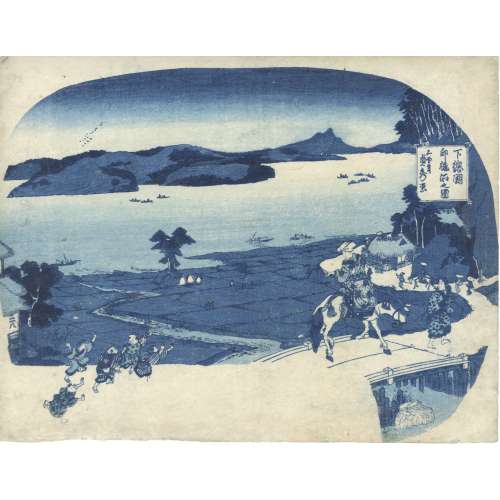 An uncut aizuri fan print showing travellers arriving at Inba Lake [印旛沼] (Inba-numa) on Shimosa Plateau [下総台地] (Shimōsa-daichi). Artist: Utagawa Sadahide [歌川貞秀] (Japanese, 1807 – 1879) Publisher: Unknown. Published: c. 1849. Signed: Gountei Sadahide ga [五雲亭 貞秀画] (Picture by Gountei Sadahide). Inscription in cartouche: Shimosa Plateau, Inbanuma (Inba Lake) [下總國印幡沼]. No date seal, no censor seal (privately printed?) Media: Fan print [団扇絵] (uchiwa-e), 235 x 300 mm.
An uncut aizuri fan print showing travellers arriving at Inba Lake [印旛沼] (Inba-numa) on Shimosa Plateau [下総台地] (Shimōsa-daichi). Artist: Utagawa Sadahide [歌川貞秀] (Japanese, 1807 – 1879) Publisher: Unknown. Published: c. 1849. Signed: Gountei Sadahide ga [五雲亭 貞秀画] (Picture by Gountei Sadahide). Inscription in cartouche: Shimosa Plateau, Inbanuma (Inba Lake) [下總國印幡沼]. No date seal, no censor seal (privately printed?) Media: Fan print [団扇絵] (uchiwa-e), 235 x 300 mm. -
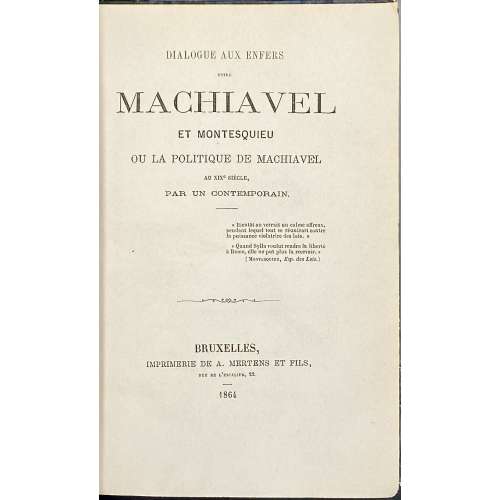 Title page: DIALOGUE AUX ENFERS | ENTRE | MACHIAVEL | ET MONTESQUIEU | OU LA POLITIQUE DE MACHIAVEL | AU XIXe SIÈCLE, | PAR UN CONTEMPORAIN. | {6 lines of citations} | ~ | BRUXELLES, | IMPRIMERIE DE A. MERTENS ET FILS, | RUE DE L’ESCALIER, 22. | – | 1864 || Description: 19 x 12.7 cm, quarter green morocco over blue marbled boards, spine with raised bands ruled in gilt, gilt fleurons in compartments, gilt lettering, marbled endpapers; three paper clippings laid in. Collation: 12mo; π5 1-2712 292; total 175 leaves. Pagination: [2] blank, [2] h.t, [2] t.p. [i] ii-iii [iv] [1] 2-337 [338] blank [2] errata]; total 350 pages. Contributors: Maurice Joly (French, 1829 – 1878) – author. Characters: Niccolò Machiavelli (Italian, 1469 – 1527) Charles Louis de Secondat, baron de La Brède et de Montesquieu (French, 1689 – 1755) The publication was funded by the author and smuggled into France. See other copies: LIB-2913.2021, LIB-1034.2016 and LIB-0460.2015. Other related objects: SVVP-0062.2021. Seller's description: [JOLY (Maurice)]: Dialogue aux enfers entre Machiavel et Montesquieu. Bruxelles, Mertens et fils, 1864 ; un volume in 12, demi-chagrin vert orné de l'époque. C'est dans ce livre que Joly écrit, au prétexte d'une discussion philosophique et politique, comment Napoléon III, selon lui, a manipulé les milieux économiques, la presse, l'opinion publique, les syndicats, les milieux ouvriers, le peuple, etc., pour établir un pouvoir politique fort, ce qui lui valut un séjour de 15 mois à la prison Sainte-Pélagie à Paris.
Title page: DIALOGUE AUX ENFERS | ENTRE | MACHIAVEL | ET MONTESQUIEU | OU LA POLITIQUE DE MACHIAVEL | AU XIXe SIÈCLE, | PAR UN CONTEMPORAIN. | {6 lines of citations} | ~ | BRUXELLES, | IMPRIMERIE DE A. MERTENS ET FILS, | RUE DE L’ESCALIER, 22. | – | 1864 || Description: 19 x 12.7 cm, quarter green morocco over blue marbled boards, spine with raised bands ruled in gilt, gilt fleurons in compartments, gilt lettering, marbled endpapers; three paper clippings laid in. Collation: 12mo; π5 1-2712 292; total 175 leaves. Pagination: [2] blank, [2] h.t, [2] t.p. [i] ii-iii [iv] [1] 2-337 [338] blank [2] errata]; total 350 pages. Contributors: Maurice Joly (French, 1829 – 1878) – author. Characters: Niccolò Machiavelli (Italian, 1469 – 1527) Charles Louis de Secondat, baron de La Brède et de Montesquieu (French, 1689 – 1755) The publication was funded by the author and smuggled into France. See other copies: LIB-2913.2021, LIB-1034.2016 and LIB-0460.2015. Other related objects: SVVP-0062.2021. Seller's description: [JOLY (Maurice)]: Dialogue aux enfers entre Machiavel et Montesquieu. Bruxelles, Mertens et fils, 1864 ; un volume in 12, demi-chagrin vert orné de l'époque. C'est dans ce livre que Joly écrit, au prétexte d'une discussion philosophique et politique, comment Napoléon III, selon lui, a manipulé les milieux économiques, la presse, l'opinion publique, les syndicats, les milieux ouvriers, le peuple, etc., pour établir un pouvoir politique fort, ce qui lui valut un séjour de 15 mois à la prison Sainte-Pélagie à Paris. -
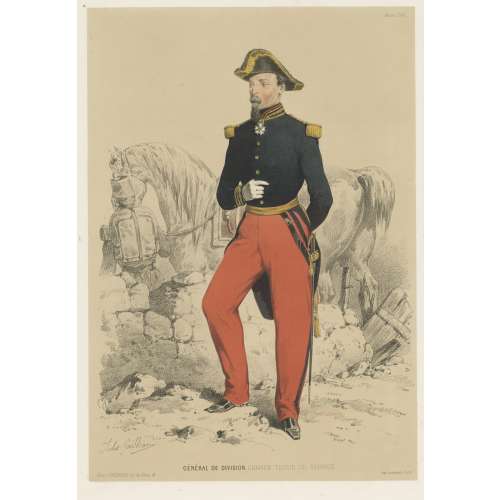 Chromolithography on thick wove paper, 473 x 315 mm sheet, 372 x 260 mm image, black ink stamp “5050” to reverse. Signed on stone "Jules Gaildrau"; below centre: "GÉNERAL DE DIVISION, GRANDE TENUE DE SERVICE"; Bottom left: "Paris, J. Gaildrau, rue de Seine, 16"; right: "Imp. Lemercier, Paris." Joseph Lemercier (French, 1803 – 1887) – printer. Jules Gaildrau (French, 1816 – 1898) – artist.
Chromolithography on thick wove paper, 473 x 315 mm sheet, 372 x 260 mm image, black ink stamp “5050” to reverse. Signed on stone "Jules Gaildrau"; below centre: "GÉNERAL DE DIVISION, GRANDE TENUE DE SERVICE"; Bottom left: "Paris, J. Gaildrau, rue de Seine, 16"; right: "Imp. Lemercier, Paris." Joseph Lemercier (French, 1803 – 1887) – printer. Jules Gaildrau (French, 1816 – 1898) – artist. -
 Artist: Utagawa Kunisada [歌川 国貞] a.k.a. Utagawa Toyokuni III [三代歌川豊国] (Japanese, 1786 – 1865). Signed: Ōju Toyokuni ga [応需豊国画], in a toshidama cartouche. Double nanushi censor seals: Mera & Murata (1846-50). Publisher: Kojimaya Jūbei [小嶋屋重兵衛] (Japanese, fl. c. 1797 – 1869). A beautiful woman, possibly a kabuki actor Iwai Hanshirō VIII [岩井半四郎] (Iwai Shijaku II, Iwai Kumesaburō III [岩井粂三郎], Iwai Hisajirō II, Japanese, 1829 – 1882), tuning the samisen on a veranda under the shining stars. The complete set of series Moon, Sun, Stars [月日星] (tsuki-hi-hoshi/boshi), three sources of light (sankō) [三光]:
Artist: Utagawa Kunisada [歌川 国貞] a.k.a. Utagawa Toyokuni III [三代歌川豊国] (Japanese, 1786 – 1865). Signed: Ōju Toyokuni ga [応需豊国画], in a toshidama cartouche. Double nanushi censor seals: Mera & Murata (1846-50). Publisher: Kojimaya Jūbei [小嶋屋重兵衛] (Japanese, fl. c. 1797 – 1869). A beautiful woman, possibly a kabuki actor Iwai Hanshirō VIII [岩井半四郎] (Iwai Shijaku II, Iwai Kumesaburō III [岩井粂三郎], Iwai Hisajirō II, Japanese, 1829 – 1882), tuning the samisen on a veranda under the shining stars. The complete set of series Moon, Sun, Stars [月日星] (tsuki-hi-hoshi/boshi), three sources of light (sankō) [三光]:









